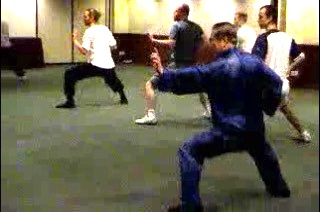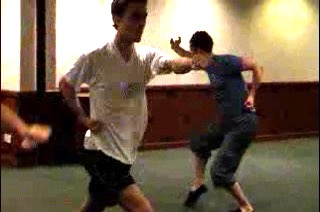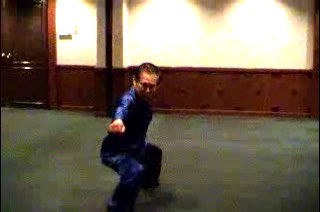FROM RANDOM FIGHTING TO PATTERNS, AND FROM PATTERNS TO SEQUENCES AND SETS
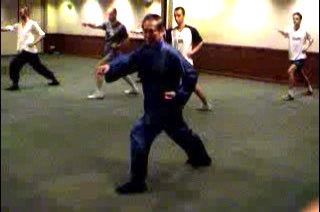 Lohan Asks the Way
Lohan Asks the Way
A common misconception is that first there were kungfu sets. Kungfu masters took patterns from the sets and found combat application for them. This was incorrect.
First there were patterns. The patterns were then linked together to form sequences, and the sequences linked together to form sets. Sometimes the patterns were linked to form sets straightaway.
More significantly, the combat application came before the patterns. In other words, it was not true that kungfu masters first thought out the patterns, then found combat application for them. Take a pattern like “Single Tiger Emerges from Cave”. It was not true that some masters invented this pattern, then they or other masters discovered how to use this pattern for combat, like defending against a mid-level attack.
In reality it was the other way round. First there was combat. There were no patterns. When someone was attacked at mid-level, he would attempt to ward it off randomly or instinctively. He might, for example, lift up his arm horizontally to block while standing with feet apart in an ordinary manner.
Gradually those who fought frequently found out that such random movements had many disadvantages. For example, blocking with a horizontal arm might not stop a powerful attack penetrating through, and keeping the legs apart would expose their groin. These frequent fighter discovered that by adopting certain postures and moving their hands in certain manners, they could defend against a mid-level attack more effectively. This took a long time to evolve, but eventually these preferred ways were stylized into a pattern like “Single Tiger Emerges from Cave”.
In the next developmental stage, patterns were linked to form sequences. Then sequences were linked to form sets.
Kungfu patterns and subsequently sequences and sets were born out of combat. But the evolution of kungfu has become so sophisticated that the original functions of patterns may not be discernable to many people today. Eventually most kungfu practitioners do not know the original combat function of the patterns they perform.
The video series here shows participants at the Intensive Shaolin Kungfu Course of October 2006 relive this aspect of kungfu development. Some abilities common to Shaolin Wahnam practitioners but puzzling to many other people, like being forceful yet relaxed, and being able to spar for more than an hour without panting for breaths, have their source shown in these videos.
 Linking Patterns into a Sequence
Linking Patterns into a Sequence
The four attack and the four defend patterns are linked together to form a sequence. The underlying principle in the linkage is to perform an attack then its defence for middle, top, bottom and side strikes. One useful purpose is that by practicing just this sequence, you have learnt the techniques enabling you to handle all strikes! This is a very cost-effective way of learning.
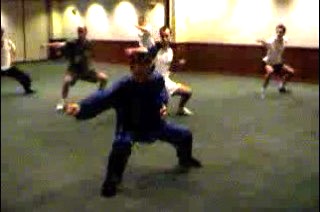 Linking Sequences to form a Set
Linking Sequences to form a Set
The sequence of eight patterns is repeated using the other left-right mode. Then we turn around and repeat these two sequences again. Hence, the sequence is performed four times, and the sequence code is right-left-left-right. These four sequences form a set, which we call “Lohan Asks the Way”.
This set, “Lohan Asks the Way”, is composed of four sequences, which in turn is composed of the basic patterns for striking and their defence. Some patterns are added to facilitate transition. The set is performed here pattern by pattern.
 Condensation of Effective Fighting
Condensation of Effective Fighting
The participants have experienced how sets came into being. First, people fought randomly. Then those effective ways of fighting were formalized into patterns. The patterns were linked together to form sequences, and then sequences were linked together to form sets. A kungfu set, therefore, is a condensation of effective ways of fighting.
There are a few ways of moving forward, such as the roll-step, the drag-step and the shoot-step. Here, in progression, the shoot-step is deonstrated.
This video clip shows participants practicing “Lohan Asks the Way”. This is the basic set to practice patterns for handling all kinds of strikes!
The secrets of breath control in performing the set is explained. We can perform the set pattern by pattern, with one breath per pattern. Here one breath is used to perform a series of patterns.
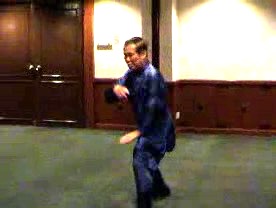 Fast and Forceful but Not Out of Breath
Fast and Forceful but Not Out of Breath
The set comprising four sequences can be performed in four breaths instead of thirty six breaths pattern by pattern. In this way, the whole set can be performed fast and forcefully, yet the participants will not be out of breath or tired.
From Random fighting to Patterns, then to Sequences and Sets from Wong Kiew Kit on Vimeo.
1. Stances: the Foundation for Internal Force and Combat Efficiency
2. Footwork Secrets for Health, Efficiency and Elegance
3. Moving into a Same Direction using Different Ways to Gain Advantages
4. Picture-Perfect Forms and Flowing Movements
5. From Random Fighting to Patterns, and from Patterns to Sequences and Sets
6. One-Step Sparring to Develop Combat Skills
7. From Pre-Arranged Sparring to Guided Sparring
8. Using Techniques and Tactics in Sparring
9. The Five Basic Kicks
10. The Secrets of Side Kicks and Continuous Cannons
11. How You may Defeat Opponents Experienced in Random Free Sparring
12. How Would a Fragile Girl Counter a Powerful Sweeping Kick from a Muay Thai Fighter?
13. Shaolin Felling Techniques and their Defences
14. Safety First Before Executing Felling Techniques
15. From Combat Sequences to Free Sparring
16. Sixteen Combat Sequences and Five Kungfu Sets
17. Surprise your Attacker with a Counter-Attack
18. Working out Ways to Fight a Boxer
19. Effective Tactics and Techniques against Boxers
20. From Gross Outline to Fine Details
21. Exploiting Advantage to Clinch Victory
22. Variety of Kungfu Techniques against Boxers
23. Analysis of Techniques Used against Boxers
24. Using Shaolin Kunfu against Boxing in Free Sparring
25. Effective Shaolin Tactics and Techniques against Kick-Boxing
26. Shaolin Kungfu against Kick-Boxing in Free Sparring
27. How to Handle a Karate Exponent
28. How to Handle a Taekwondo Exponent
29. How to Handle a Wrestling Exponent
30. Understanding the Typical Attacks of Muay Thai Fighters
31. Grandmaster Ho's Secrets in Countering Muay Thai Fighters
32. First Avoid Defeat, Then Secure Victory
33. Counteroing the Elbow and Knee Attacks of Muay Thai Fighters

